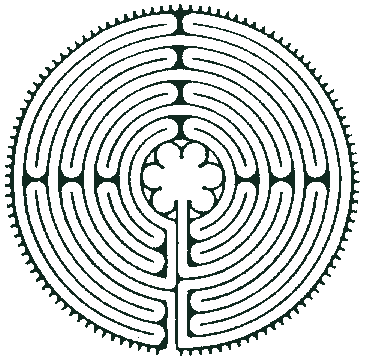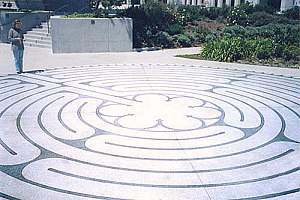

|
The Beach Labyrinth |
Again this autumn I returned to my favorite beach camp, a tiny, little-known spot where you park your van on the sand and walk over a low dune to the pounding waves of the Pacific.
A couple of nights here, quiet with your thoughts and eventually without them if you're lucky, and you can get your steps back on the path that's uniquely your own. (At least, that's what I like about this camp. Others come here to fish for steelhead in the river. Whatever works...)
The camp is a real bear to reach, so I pulled in late in the day. I got in a short walk beside the breakers at twilight, and on the way back to camp I swung over to the dune where the labyrinth lay.
|
The labyrinth was built of stones, carried up from the water's edge, and artfully arranged in the beach sand to form a classical labyrinth. The design was reminiscent of the labyrinth in the courtyard of Grace Cathedral in San Francisco, which in turn is based on the medieval labyrinth in the floor of the cathedral at Chartres, France.
The courtyard labyrinth outside Grace Cathedral.
Photograph courtesy of Allen Bacque, AIA. |

|
The web site "Lessons for Living" says of the labyrinth at Chartres:
|
The classical labyrinth has an association with Christianity. A cross is the starting point used to construct this labyrinth. The cross at the center can become the focus for meditation and the experience of the labyrinth.
Chartres Cathedral.
|

|
When you walk a labyrinth, you can pray, or meditate, or reverently do whatever it is your better instincts prompt you to do. I've walked the labyrinth at Grace Cathedral many times, simply hoping that I'd be a better person tomorrow than I was yesterday.
So I was glad to find the beach labyrinth still there, and not destroyed by the storms last winter. I could barely see its outer edge in the failing light, so I decided to walk it early in the morning. What a clean and innocent way to begin a day!
Before breakfast I unwrapped the token I had brought with me (traditionally you leave a token at the labyrinth's center) and climbed over the dune to the labyrinth.
Daylight revealed a terrible thing.
In the deep twilight the night before, I had not seen that only a fragment of the labyrinth remained. Most of the stones had been removed and rearranged nearby. Evidently months ago, someone had taken the stones and spelled out the word "Jesus."
The letters were large and carefully constructed. This was not the work of children, but of careful, determined adults. I can't know what they were thinking, but presumably, they wouldn't have torn apart a large, artfully designed crucifix in order to spell "Jesus." I think they acted in ignorance of the history of the labyrinth, and its continued use as a Christian symbol and aid to prayer.
How is it that we modern people discourage action based in ignorance in every aspect of our lives, except for that single area of greatest mystery, religion?
Too many of us have the utmost certainty about that which is most subtle, so far beyond the capacity of the human mind. For a simple example, as a child I was taught that "God is All-Just." As a child I was good with that, but as an adult, I am staggered to consider all the implications. This apparently simple truth is beyond the understanding of a human mind within a human lifetime. Clearly, these are not matters that thinking can resolve.
As Martin Gardner has written, since we cannot prove the truth of religion, we must rely on feeling its truth. But it must give us pause when we meet someone from a different background, someone as well-intentioned as ourselves, who is just as kind, thoughtful, brave, clean, and reverent, and yet believes something very different from us, and believes it just as sincerely and strongly.
Meeting a reverent person who feels a different truth from our own seldom leads us to adjust our own truth. It must, however, make us tolerant. Perhaps somehow you and that other person are both right, or both wrong—since you're feeling your way through the ultimate mystery, it shouldn't surprise you if it's bigger than you ever expected!

|
Tolerance teaches that it doesn't matter who is right and who is wrong. A reverent person will permit others of good intention to practice what they feel is reverent.
To ignorantly destroy a means of prayer cannot please any worthy deity.
It is surely a sin to justify ignorant actions in any of the names of the Ultimate.
October 2001 |
Back to The NuMoon Reader Index